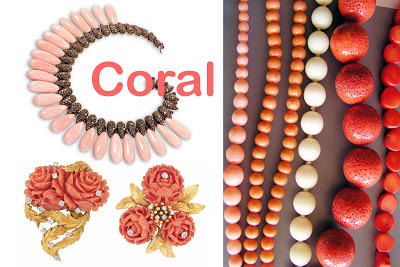At an Indian wedding apart from Diamond, a gemstone that is impossible to miss is Coral. Considered very auspicious and as a giver of life, Precious Coral or red Coral is made up of the skeletal remains of marine animals called coral polyps. These tiny creatures live in colonies that form branching structures as they grow, eventually forming Coral reefs and atolls. The distinguishing characteristic of precious corals (Corallium rubrum) is their durable and intensely colored red or pink skeleton, which is used for making jewelry.

Varieties
Most Corals – red, pink, white and blue varieties – are made of calcium carbonate (Caco3). They are chemically very similar to pearls but very different in appearance. However black and golden Corals or Hawaiian corals are made of a hornlike substance called conchiolin. The hard skeleton of red coral branches is naturally matte, but can be polished to a glassy shine. Intensely red coral called fire coral, is rare and is highly prized as a gemstone. Owing to its intense and permanent coloration and glossiness, precious coral skeletons have been harvested since antiquity for decorative use. Since the coral reefs have been extensively over-harvested and under thread through environmental changes, harvesting is very restricted and Coral has become exceptionally expensive.
Myths & Beliefs
From Time immemorial Coral is believed to posses medicinal and spiritual properties. Indians believe that it clears chest cold and protects the heart. In Hindu astrology red coral is associated with the planet Mars. In Greek Mythology, Poseidon is said to have resided in a palace made of coral and gems, and Hephaestus first crafted his work from coral. Ancient Romans hung branches of coral around children’s necks to preserve them from danger. In 20th century Italy it was worn as a preservative from the evil eye, and by females as a cure for sterility. It is also used to teach the value of family and concept of living harmoniously together.
Corals are used in Jewelry in three forms – beads, branches and cabochons (flat backed domes). Even natural coral beads are available in a variety of shapes like round, cylindrical, tear drop and as heishi. Beware -Most Coral, especially the cheap varieties are not precious coral, but sponge or branch coral and is in most cases dyed to create the bright colour. It is also widely imitated by porcelain, stained bone, glass, plastic or rubber and gypsum mixtures. If you would rather use faux coral and not deplete the natural resources, try the DIY tutorial on how to make Faux coral jewelry.
Caring for Coral Jewelry:
Coral gemstone jewelry is easily chipped as it is lightweight, soft and delicate. It requires special care if it is to last. The stones may sustain damage if exposed to chemicals like perfumes and sprays. When you clean the coral jewelry, you should wipe your coral pieces with a clean, damp, soft cloth, and allow them to air dry before storing. After the coral dried, store coral in individual bags or a lined box away from your other pieces of jewelry to avoid scratching.
I hope you find it interesting
Cheers



One response to “Gems & Jewelry – Corals”
[…] Coral, As you must read about in my last Lapidary information post is a fast becoming a rare commodity. But its beauty continues to fascinate. If you are looking for an economical way to create the look of coral for less, here is your answer – Create faux Coral sprig Jewelry. […]